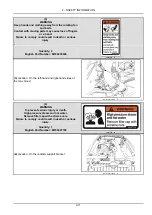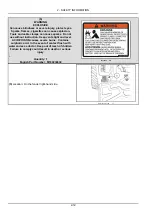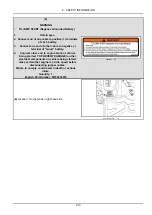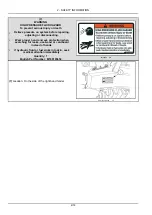
2 - SAFETY INFORMATION
Seat belts are part of your protective system and must be
worn at all times. The operator must be held to the seat
inside the frame in order for the protective system to work.
Personal Protective Equipment (PPE)
Wear Personal Protective Equipment (PPE) such as hard
hat, eye protection, heavy gloves, hearing protection, pro-
tective clothing, etc.
Do Not Operate tag
Before you start servicing the machine, attach a ‘Do Not
Operate’ warning tag to the machine in an area that will
be visible.
Hazardous chemicals
If you are exposed to or come in contact with hazardous
chemicals you can be seriously injured. The fluids, lu-
bricants, paints, adhesives, coolant, etc. required for the
function of your machine can be hazardous. They may
be attractive and harmful to domestic animals as well as
humans.
Material Safety Data Sheets (MSDS) provide information
about the chemical substances within a product, safe
handling and storage procedures, first aid measures, and
procedures to take in the event of a spill or accidental
release. MSDS are available from your dealer.
Before you service your machine check the MSDS for
each lubricant, fluid, etc. used in this machine. This in-
formation indicates the associated risks and will help you
service the machine safely. Follow the information in the
MSDS, and on manufacturer containers, as well as the in-
formation in this manual, when you service the machine.
Dispose of all fluids, filters, and containers in an environ-
mentally safe manner according to local laws and regula-
tions. Check with local environmental and recycling cen-
ters or your dealer for correct disposal information.
Store fluids and filters in accordance with local laws and
regulations. Use only appropriate containers for the stor-
age of chemicals or petrochemical substances.
Keep out of reach or children or other unauthorized per-
sons.
Applied chemicals require additional precautions. Obtain
complete information from the manufacturer or distributor
of the chemicals before you use them.
Utility safety
When digging or using ground-engaging equipment, be
aware of buried cables and other services. Contact your
local utilities or authorities, as appropriate, to determine
the locations of services.
Make sure that the machine has sufficient clearance to
pass in all directions. Pay special attention to overhead
power lines and hanging obstacles. High voltage lines
may require significant clearance for safety. Contact local
authorities or utilities to obtain safe clearance distances
from high voltage power lines.
Retract raised or extended components, if necessary.
Remove or lower radio antennas or other accessories.
Should a contact between the machine and an electric
power source occur, the following precautions must be
taken:
• Stop the machine movement immediately.
• Apply the parking brake, stop the engine, and remove
the key.
• Check if you can safely leave the cab or your actual po-
sition without contact with electrical wires. If not, stay
in your position and call for help. If you can leave your
position without touching lines, jump clear of the ma-
chine to make sure that you do not make contact with
the ground and the machine at the same time.
• Do not permit anyone to touch the machine until power
has been shut off to the power lines.
Electrical storm safety
Do not operate machine during an electrical storm.
If you are on the ground during an electrical storm, stay
away from machinery and equipment. Seek shelter in a
permanent, protected structure.
If an electrical storm should strike during operation, re-
main in the cab. Do not leave the cab or operator’s plat-
form. Do not make contact with the ground or objects
outside the machine.
Mounting and dismounting
Mount and dismount the machine only at designated lo-
cations that have handholds, steps, and/or or ladders.
Do not jump off of the machine.
Make sure that steps, ladders, and platforms remain
clean and clear of debris and foreign substances. Injury
may result from slippery surfaces.
Face the machine when you mount and dismount the ma-
chine.
Maintain a three-point contact with steps, ladders, and
handholds.
Never mount or dismount from a moving machine.
Do not use the steering wheel or other controls or acces-
sories as handholds when you enter or exit the cab or
operator’s platform.
2-6
Summary of Contents for Workmaster 25S
Page 20: ...1 GENERAL INFORMATION 1 14 ...
Page 102: ...3 CONTROLS AND INSTRUMENTS 3 40 ...
Page 118: ...4 OPERATING INSTRUCTIONS 4 16 ...
Page 186: ...7 MAINTENANCE 7 50 ...
Page 199: ...9 SPECIFICATIONS NHIL17CT01125FA 1 NHIL17CT01124FA 2 9 9 ...
Page 200: ...9 SPECIFICATIONS 9 10 ...













































